The MSI Prestige 14 Evo Review: Testing The Waters Of Tiger Lake
by Brett Howse on December 17, 2020 10:00 AM EST- Posted in
- Laptops
- Intel
- MSI
- Tiger Lake
- Notebook
Display Analysis
As the name suggests, the MSI Prestige 14 Evo features a 14-inch display, and MSI has gone with the more standard 1920x1080 IPS panel, meaning a 16:9 aspect ratio. That is somewhat disappointing, as competing laptops have started to transition to taller displays in the 16:10 and 3:2 range.
The laptop offers no touch support either, so this is as traditional of a clamshell Ultrabook as you can get. Some may not like touch, but for a wider audience, having a feature and not using it is better than not having it at all.
 Sub-pixel arrangement. The haze is the matte coating on the display.
Sub-pixel arrangement. The haze is the matte coating on the display.
The 1920x1080 resolution in this screen size means the laptop offers 157 pixels-per-inch in terms of display density. There is always a tradeoff for density versus battery life, and although 157 is pretty far from what you would consider a high DPI panel, it still works well in this form factor. Out of the box, Windows sets this to 150% scaling, although you can of course adjust if you want more real estate. 125% seems to work pretty well. There is no UHD display option, but as we have seen in other devices which offer UHD, the hit to battery life is significant, so sticking with a more traditional 1920x1080 resolution still makes sense.
The display targets sRGB, and although some competing devices may offer P3 or Adobe RGB gamut support, the lack of a system-wide color management system in Windows still unfortunately means sRGB is better for most people. If you use professional applications that can correctly manage color, the MSI Prestige is likely not for you, but for the average consumer using content that is likely over 99% of the time targeting sRGB, MSI has made the right choice here.
To see how the MSI Prestige 14 Evo fares in terms of color accuracy and contrast, we have run it through a custom workflow in Portrait Display’s Calman suite, using the X-Rite i1Display Pro colorimeter for brightness and contrast measurements, and the X-Rite i1Pro 2 spectrophotometer for color accuracy readings.
Brightness and Contrast
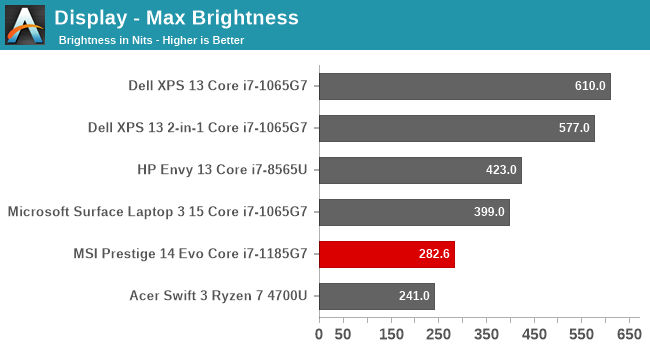
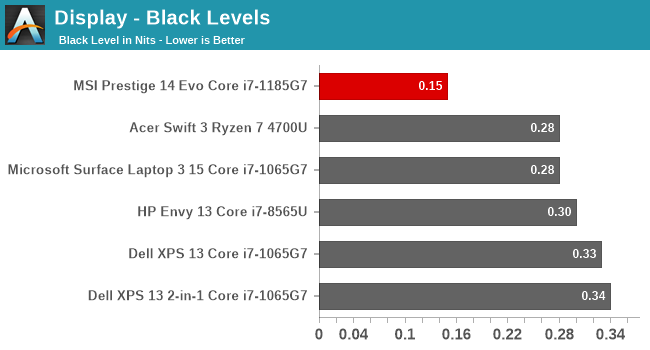
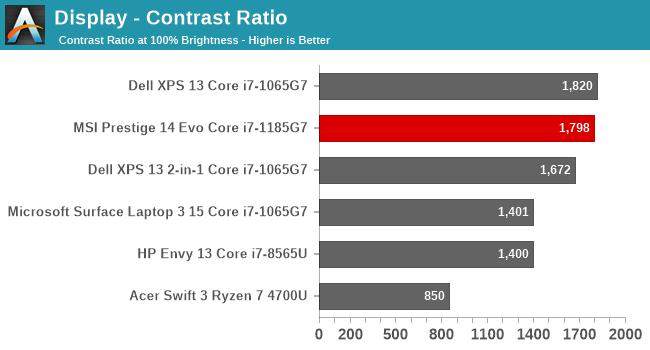
The Prestige 14 gets off to a good start in terms of display contrast, almost hitting 1800:1. The panel offers excellent black levels which help it achieve this result. It does not get overly bright though, not even hitting 300 nits at 100% brightness, and would likely struggle outdoors because of that. It does get very dim though for use in a dark room with the display going all the way down to 5 nits.
Grayscale

MSI has done a very good job on the default color profile for this laptop, with the grayscale averaging under the 3.0 level that we’d consider to be a good display. There are a couple of peaks slightly over, but nothing too dramatic. The color balance across the gray range is very consistent, with blue dropping slightly compared to red and green, but overall still doing very well.
Gamut
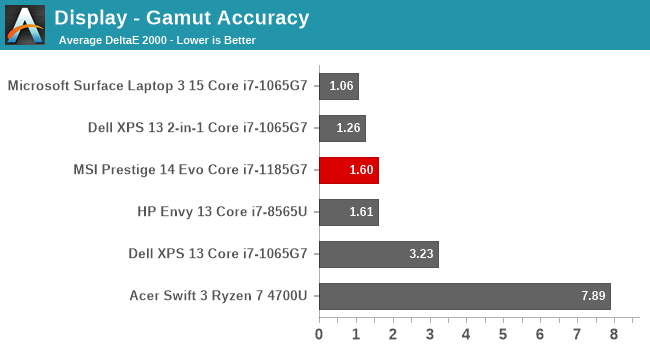
The good news continues when looking at the sRGB gamut coverage. The laptop is able to hit all of the major color points for primary and secondary colors with very little error.
Saturation
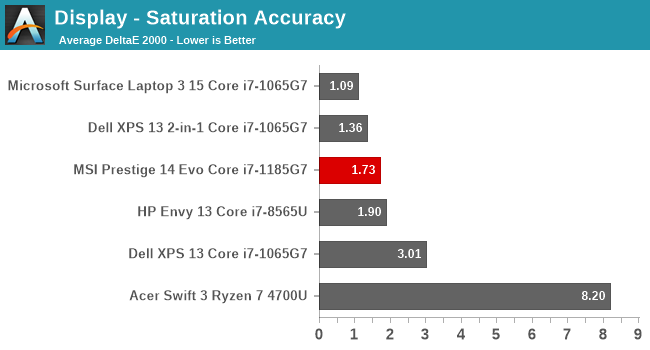
The saturation sweep does the same color targets as the gamut test, but across the entire range from 0% to 100% brightness on each primary and secondary color, tested at 4-bit intervals. None of the colors show any real error rates above the 3.0 mark, with most well under across the entire range. Clearly, MSI has done their homework and calibrated the display at the factor to achieve these levels of accuracy. There is no ICC profile included as the error correction is being done in hardware.
Gretag Macbeth

While the previous tests focus on primary and secondary colors, the Gretag Macbeth tests a much wider range of colors, including the important skin tones. Once again, the MSI Prestige 14 performs very well here, with only a couple of individual colors above the 3.0 error level, and only just. MSI has done a great job calibrating this display.
Colorchecker
While the previous graphs show error rates, the final image is the colorchecker swatch, which shows the target color on the bottom, and the achieved color by the display on the top. This gives you a better relative look at the error rate. Again, it shows the accuracy of this display.
Display Conclusion
Although the MSI Prestige 14 Evo is a mostly standard 1920x1080 16:9 display, and it just targets sRGB, MSI has done the added work to calibrate the display at the factory, which vastly improves its accuracy. Some devices use an ICC profile to fix the calibration through software, but ICC profiles can be a challenge especially if the application ignores them, so doing this through hardware is a better solution. The combination of high contrast and high accuracy make this one of the better displays available in this category.















63 Comments
View All Comments
zodiacfml - Thursday, December 17, 2020 - link
Can't read this. Why would one consider this unless one doesn't know of ASUS' Zephyrus G14 lineup?JfromImaginstuff - Friday, December 18, 2020 - link
Short answer: businessRookierookie - Monday, December 21, 2020 - link
1. The G14 is considerably heavier and thicker2. The G14 doesn't have a webcam or card reader
3. The G14 doesn't have Thunderbolt
4. The G14 doesn't have dedicated navigation keys
If you don't need a gaming laptop, the better question is, why would one consider the Zephyrus G14?
mikk - Thursday, December 17, 2020 - link
Handbrake Transcoding (Hardware): the tester has zero clue about what he is doing. Is he testing the FF/low power or the much slower Hybrid of Quicksync and what target usage did he use: quality, balanced or speed. The fully fixed function encode is really fast on Tigerlake. Pretty sure he did use the slow Hybrid+quality/balanced encode.lmcd - Friday, December 18, 2020 - link
The quality levels on fully fixed function encode are NOT uniform across vendors and is useless as a benchmark.mikk - Friday, December 18, 2020 - link
The main problem is that he most likely didn't use the fully fixed function encode mode from Tigerlake, the performance gap would be much bigger to the software version and most likely he is comparing the fixed function of Renoir against Hybrid from Tigerlake. Without any infos about the encode settings this is an useless benchmark. And even for the software version, no info what x264/x265 preset he did use. This is not a good test.Spunjji - Friday, December 18, 2020 - link
"most likely he is comparing the fixed function of Renoir against Hybrid from Tigerlake"What's your basis for making that claim?
watzupken - Thursday, December 17, 2020 - link
I feel this is where testing of laptop is very tricky because of the many variables that will affect performance. This MSI laptop is probably one of the best Tiger Lake implementation out there for sure just by virtue of the performance. But the performance of laptops with Tiger Lake CPUs vary widely (I guess it is not just a problem with Tiger Lake, but across any CPU used) depending on how aggressive is the power setting, and how well they implement cooling. Also, comparing it with the Acer Swift 3 with a Ryzen 7 4700U may not be the best idea considering its almost an entry level laptop, just a notch above the even more budget Aspire series. So I expect the parts/ components and cooling to be inferior to the Prestige 14 Evo which will affect performance results across the board.Spunjji - Friday, December 18, 2020 - link
This is a fair point. The Swift 3 has been shown a few times to be a fairly poor showing for the Ryzen 7 4700U, whereas this implementation is one of the best for Tiger Lake. Most devices with TGL do not hit these performance levels, let alone sustain them.Of course, that's a problem for platform comparison - for comparing the actual devices available to consumers, it's fair to show how close the cheaper devices can get to the performance of a premium device.
hubick - Thursday, December 17, 2020 - link
I knew I wanted Tiger Lake w two Thunderbolt 4 ports and Xe graphics (not discrete, for Linux compat), and was seriously looking at this, but ended up ordering a Razer Book 13 instead. The Razer looks a little more well made plus has vapour chamber cooling.When I was researching, I tried using MSI's online chat to ask if this had eGPU support over Thunderbolt, and the rep connected, but never responded after 30 minutes, and then "hung up" on me. I figured if that was what I should expect from MSI support, best to stay away. Not that I have any faith in *any* company to provide decent support anymore *sigh*.